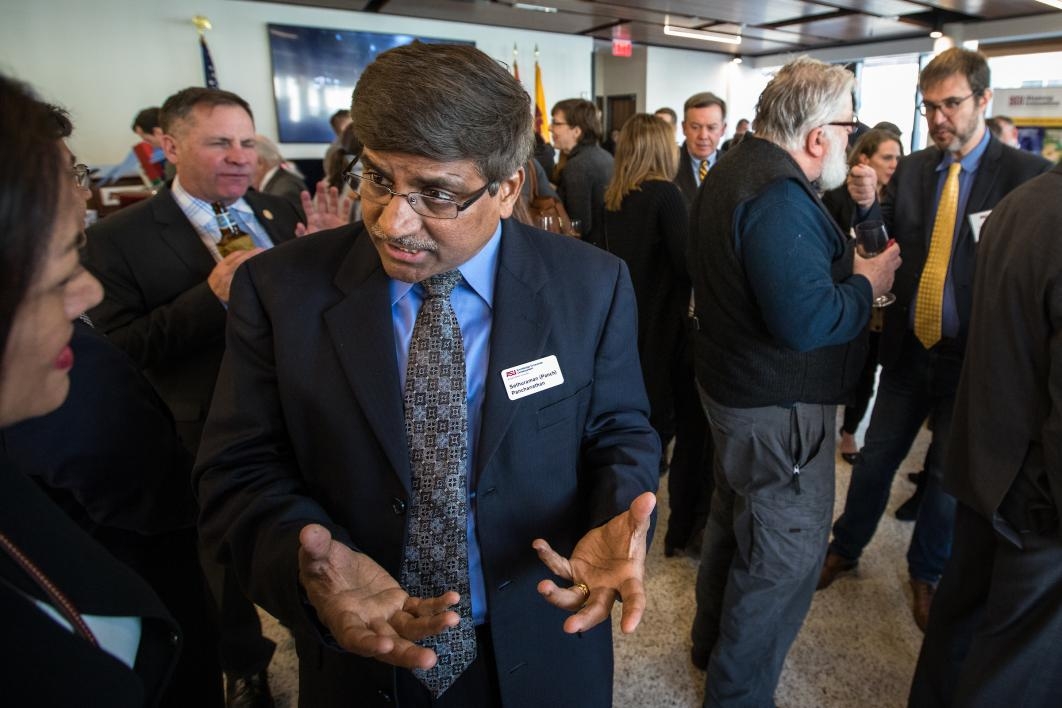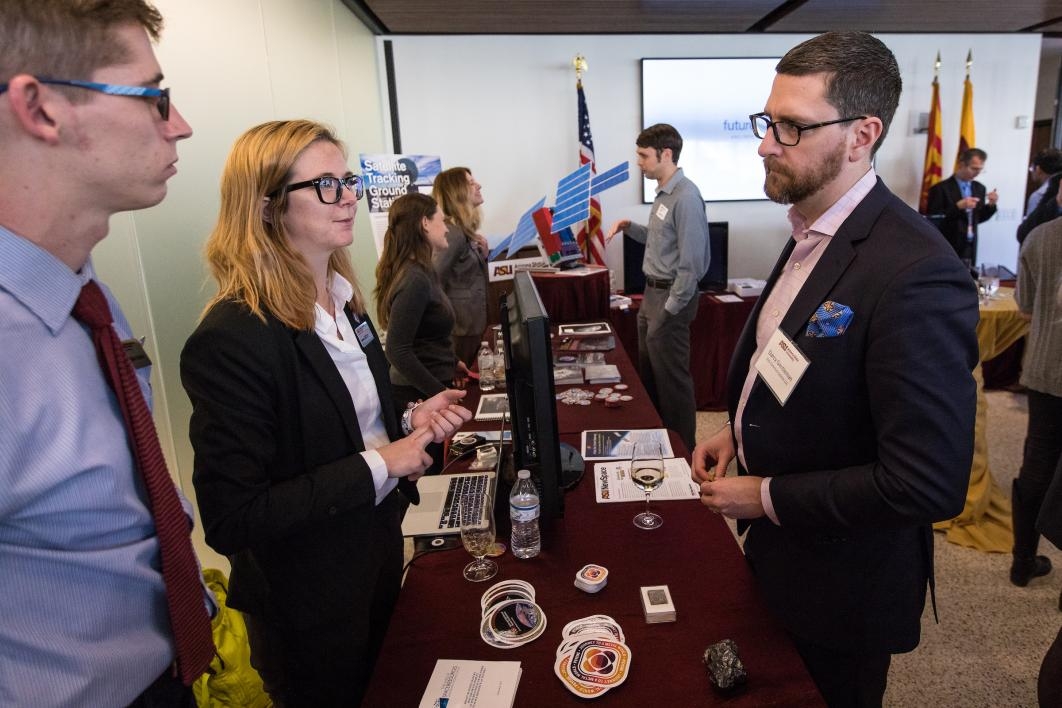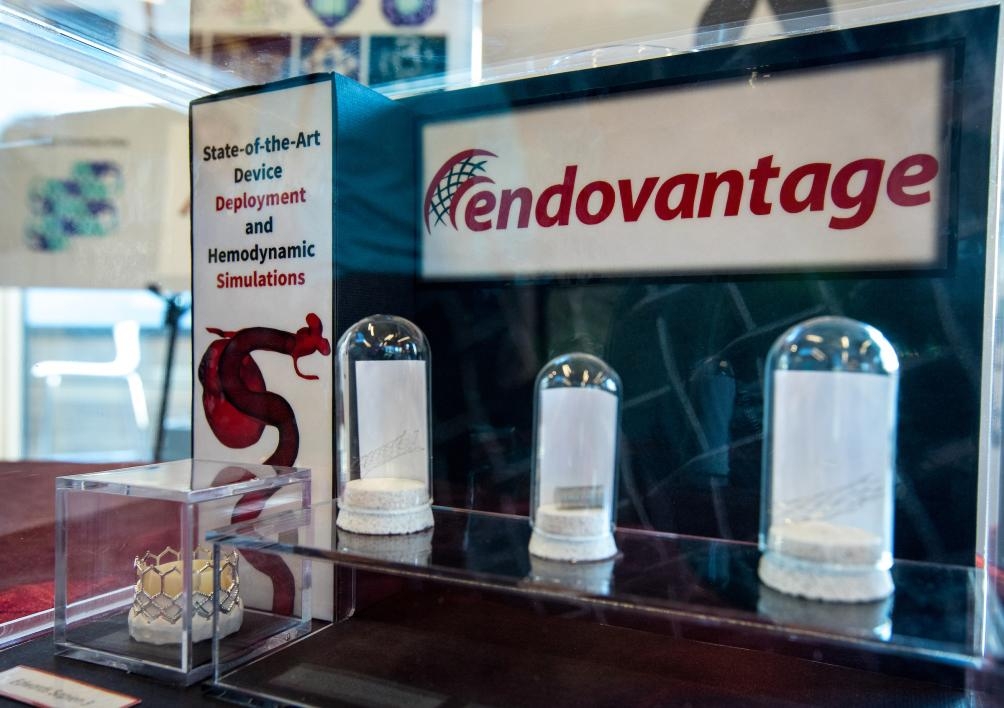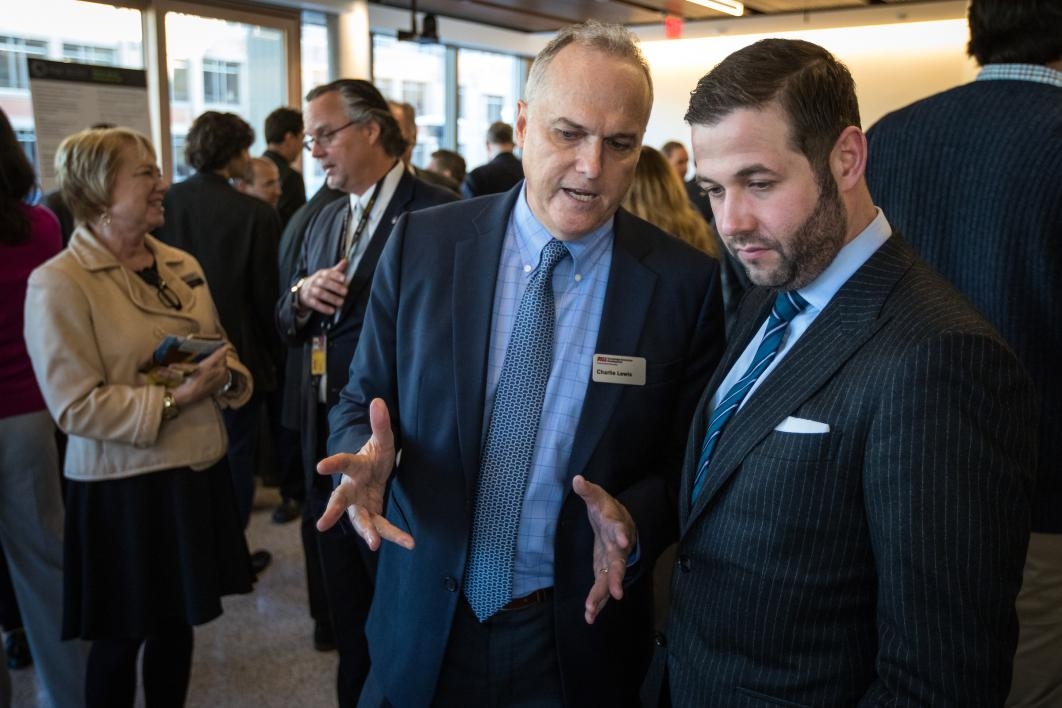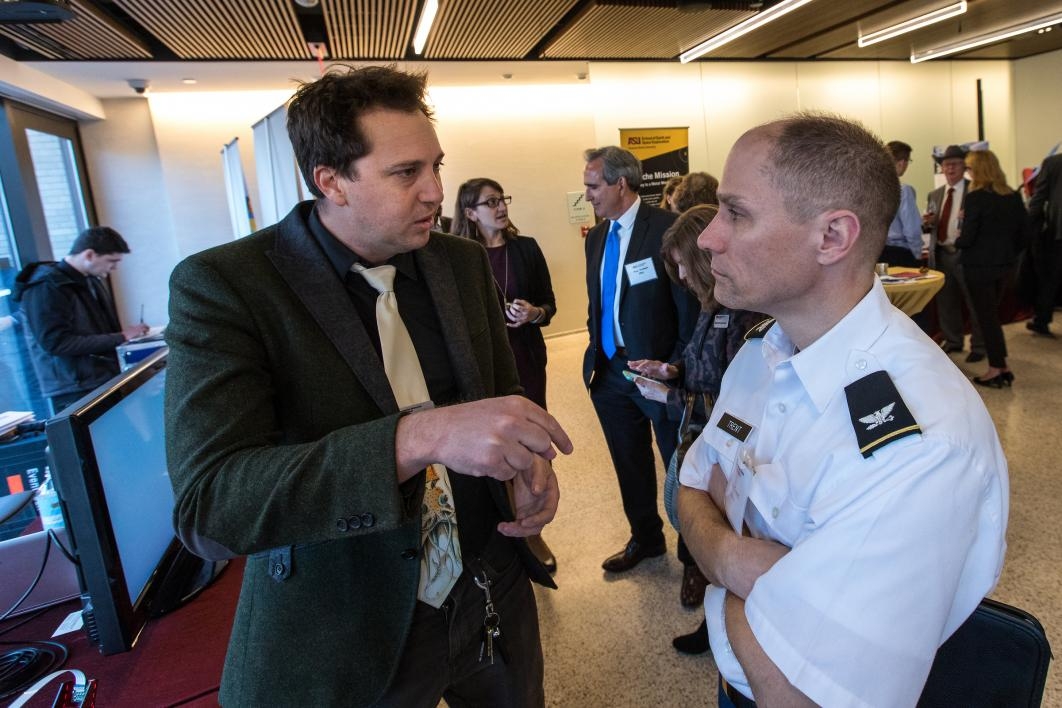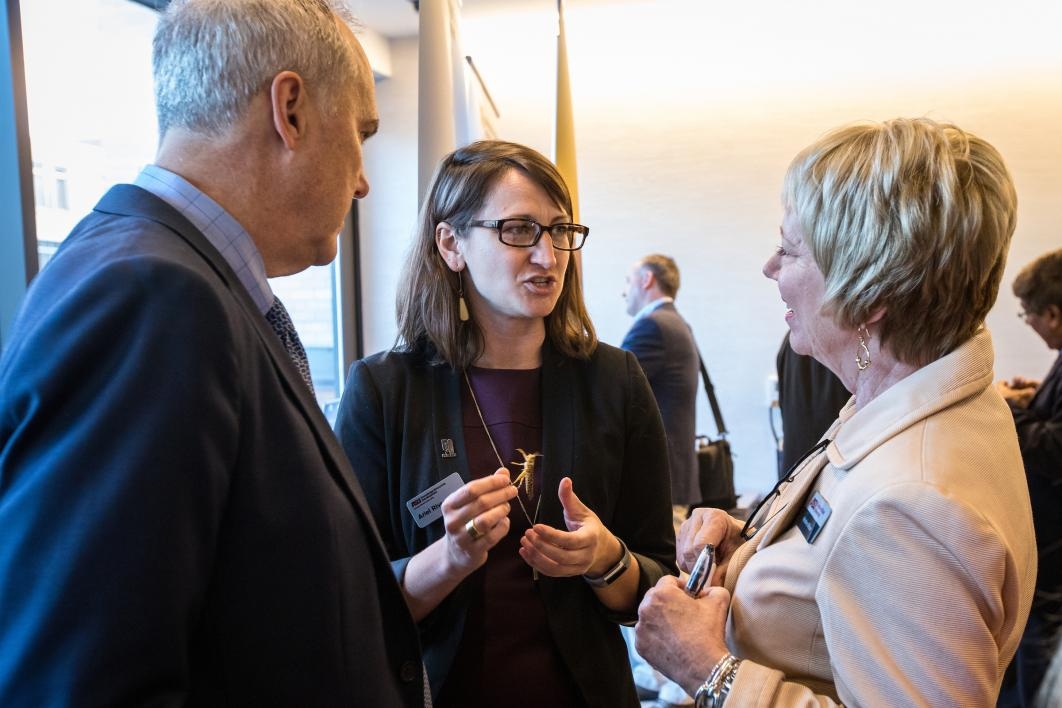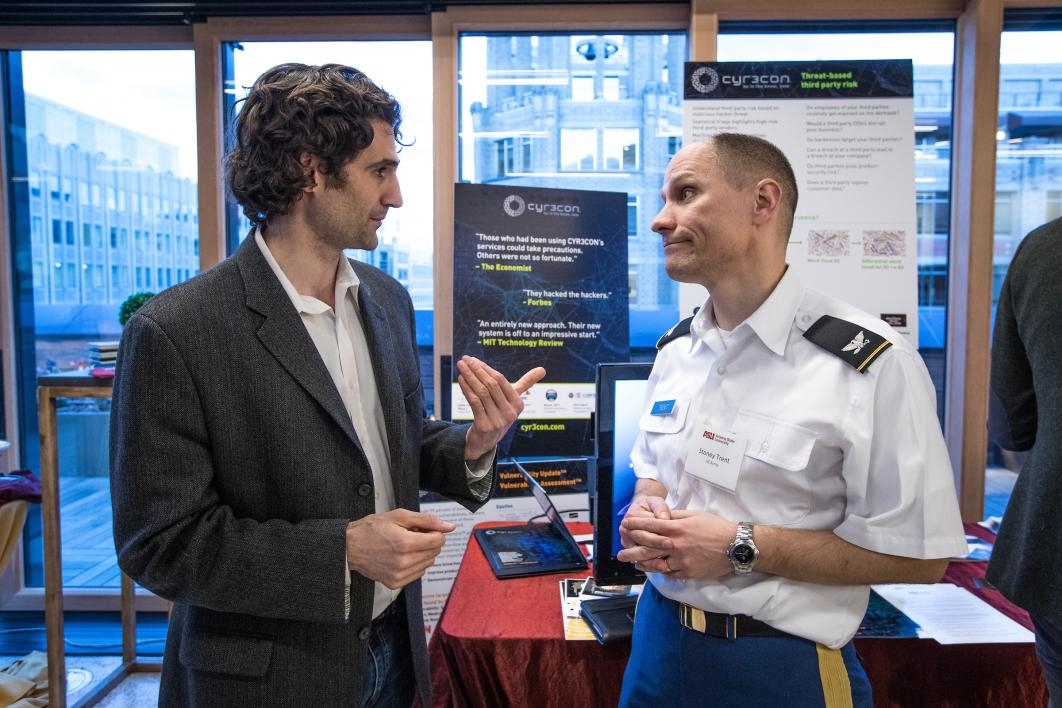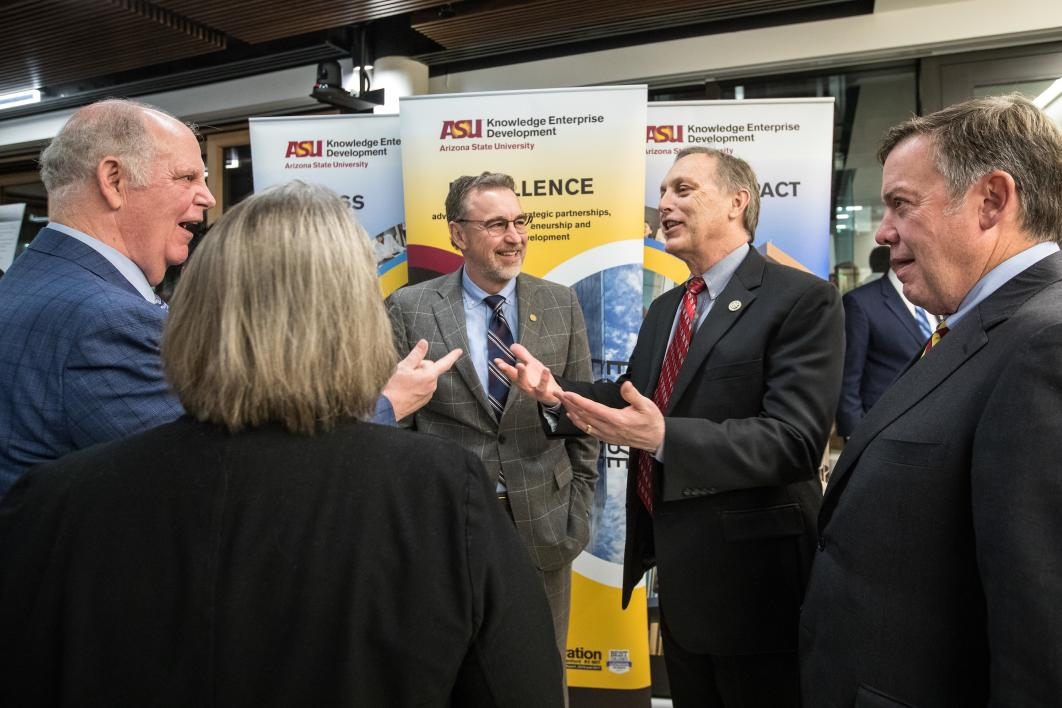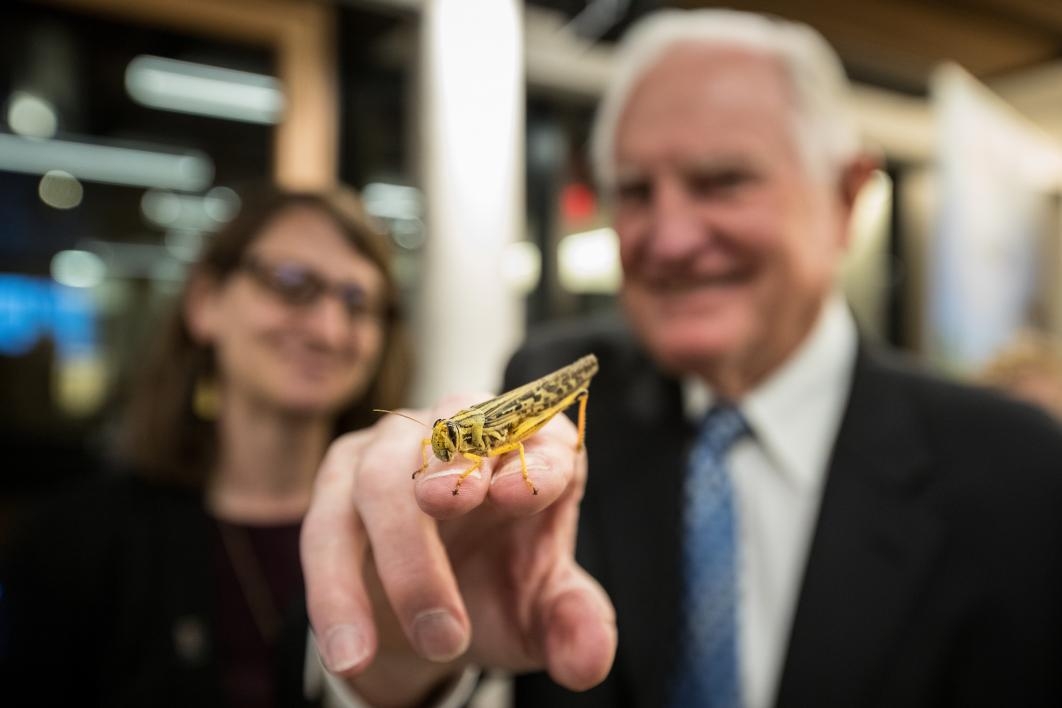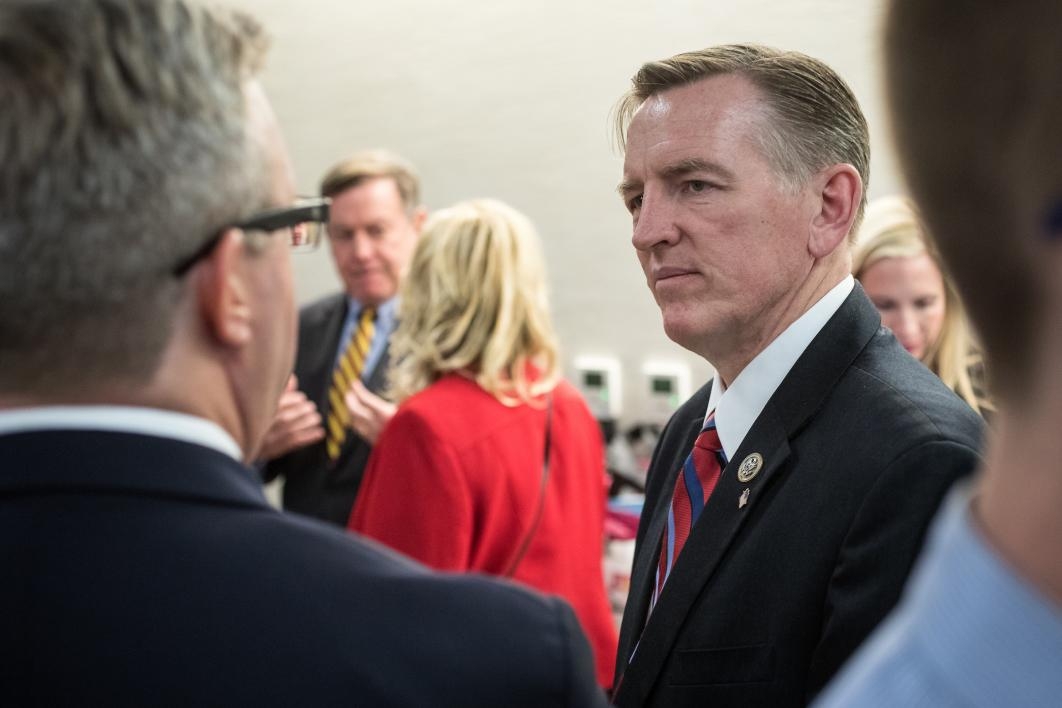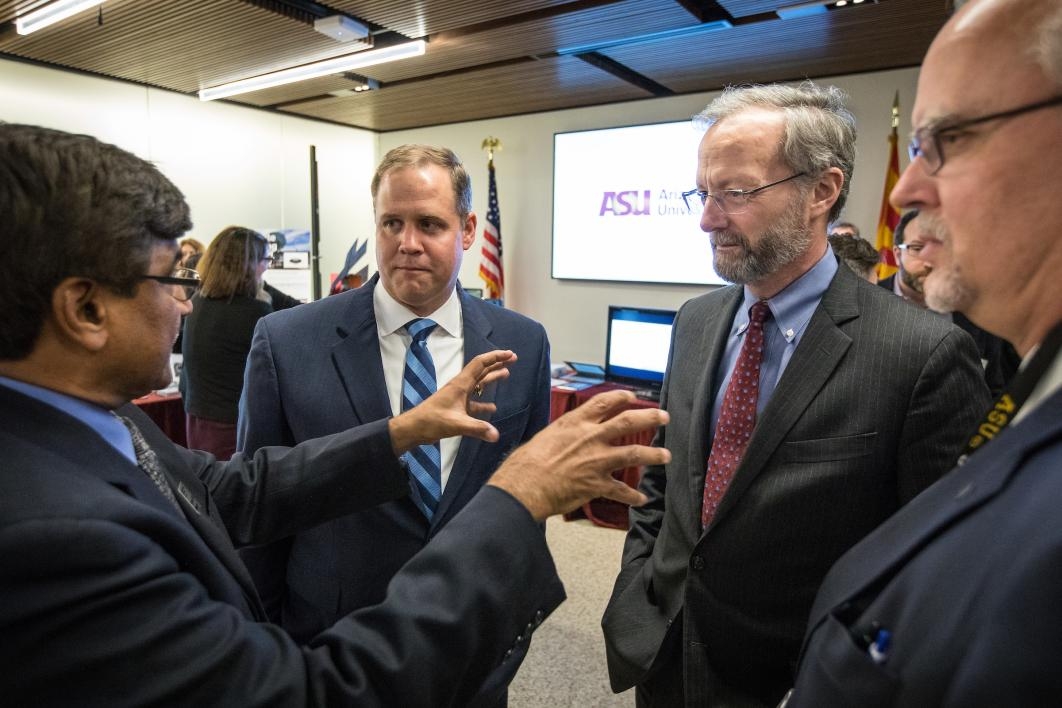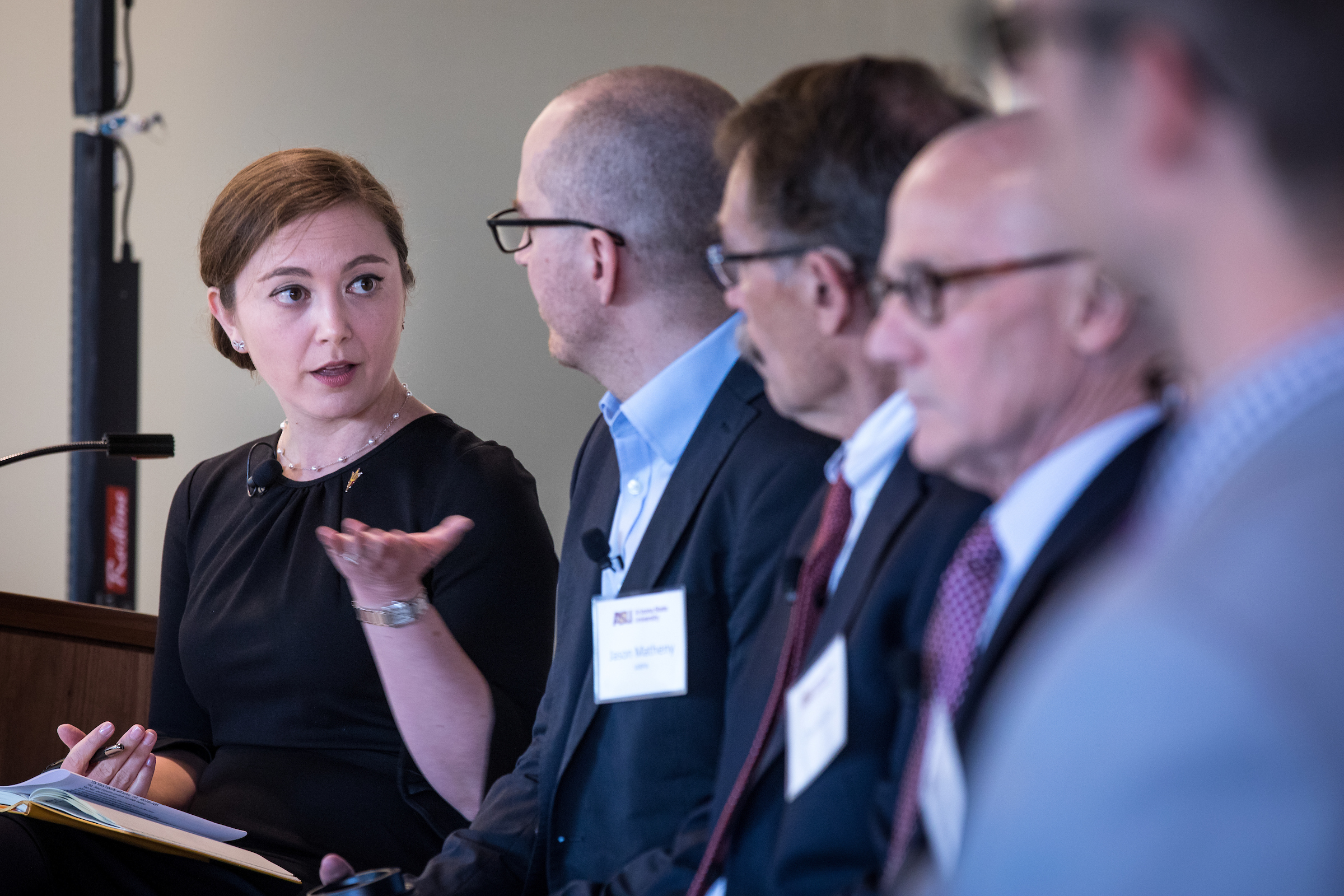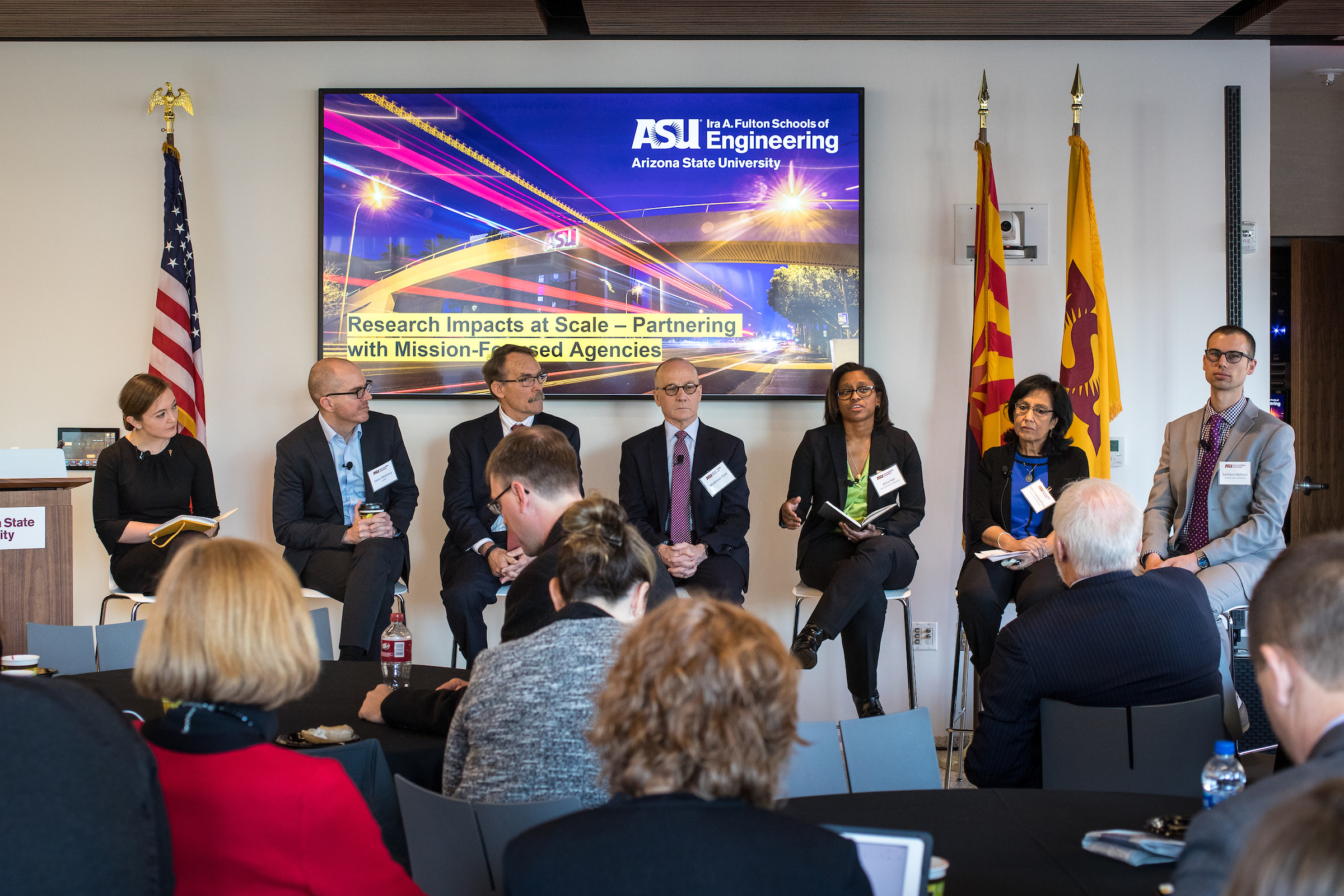Day 2: Mission-focused research, the future of autonomous cars — and locusts

Editor's note: Opening week continued at the Ambassador Barbara Barrett & Justice Sandra Day O’Connor Washington Center at ASU. Find the highlights from Day 1 here, and the current day's blog here.
Reception: Smarts in the spotlight
10:25 p.m. Tuesday, March 13
Knowledge Enterprise Development hosted a showcase and reception giving visitors — including members of Congress — a chance to look at research prototypes and mix and mingle with some of the top research thought leaders of the future from ASU. From locusts to nanobots to the dark web, the projects on display showcased some of ASU's brightest minds. Here's a sampling.
Video: The future according to Lyft exec
7:50 p.m. Tuesday, March 13
Robert Grant, senior director of global public policy and head of autonomous vehicle policy for Lyft, talks about his vision of the future for Lyft — one that is "the utopian version that we think is imminently achievable."
Video by Jamie Ell/ASU Now
Panel: 'How Will Self-Driving Cars Reshape Our Cities?'
4 p.m. Tuesday, March 13
Three separate discussions, representing views from autonomous-vehicle (AV) companies, civic planning, academic research and social science, combined in this talk covering a range of concerns about self-driving vehicles. Here are some of the highlights:
— First panel: Moderator Andrés Martinez, editorial director of Future Tense; ASU President Michael M. Crow; and Tekedra Mawakana, vice president and global head of policy and government affairs for Waymo —
ASU President Michael Crow responds to a statement by Tekedra Mawakana, a vice president with Waymo, during a panel discussion on autonomous vehicles, with moderator Andrés Martinez (left) of Future Tense. Photo by Charlie Leight/ASU Now
This is happening. Waymo, for instance, launched its early-rider test program in Phoenix last April.
Mawakana: "Right now, we have 5 million miles driven purely autonomously on public roads. We have 2.7 billion miles in simulation from 2017 alone. So the reason I’m giving you that information is people are like, 'Are you ready? How can members of the public already be in these cars?'"
Are there similar systems overall in the past we can learn from?
Crow: "Gadget-obsessed — we think somehow we’re the first humans that were gadget-obsessed. Indigenous peoples on the coast of present-day British Columbia and present-day Alaska invented and discovered without calculus a fantastic gadget called the kayak. It’s an unbelievably complicated technology that transforms a human’s ability to walk on water, to pursue food on water, to do everything imaginable.
"The same indigenous peoples built unbelievably customized tools for capturing of birds, where every bird required a different head to the arrow. … Humans have as a part of our nature, in our adaptation to everything that we encounter, been constantly developing gadgets. We just think that somehow we’re the first people that have encountered this. Because we’re encountering so many new gadgets, we’re somehow surprised, and we have this reeling, I don’t know what it is — it’s like, 'Well, do I want this gadget? Do I not want this gadget?'"
Autonomous vehicles will greatly affect truck drivers.
Crow, whose father was a truck driver after he left the Navy, driving between Nogales and Detroit carrying auto parts: "I did a run or two with him. It’s not exactly the most exciting thing in the world. It’s a living. … We’re moving to a point now, for the first time in human history, where this tool [holds up his smartphone] — computationally empowered, the chips in these are the same that are in the … Waymo cars or any other kind of autonomous vehicles — they are systems that will allow us once and for all to empower every human to not be saddled with — if they don’t want to be — with physical, repetitious work.
"… How we do it and why we do it, and how we then prepare all of those people who are no longer necessarily going to be employed doing those repetitious tasks, these are huge social questions.
"We need to be thinking about … what are we going to do now that human beings are freed from drudgery? How are we going to move them to higher levels of creativity?"
What about those who are worried autonomous cars won’t have the ability to react to changing conditions or won’t be experienced enough?
Mawakana: "When I was 16, I took a 30-minute test, someone gave me a license, someone else gave me a car. In hindsight, that doesn’t seem like the most prudent thing." Waymo is testing millions of scenarios. "There will always be highly unanticipated scenarios, but that’s what we’re building for."
What about those who don’t want self-driving cars?
Mawakana: "There will continue to be car enthusiasts."
Martinez: "There are who people who still ride horses. But they’re not doing it on the streets."
Crow: "There are more people riding horses today than there ever were in the American West. There are more horses than there were in the American West."
Martinez: "That’s tomorrow’s event." [laughter]
Crow: "We become segmented — we don’t realize the complexity of a country of 325 million autonomous individuals. The autonomy here is the individual, not the technology. People will be using these technologies to augment themselves, and companies will be using them to augment themselves and their businesses and so forth to enhance productivity.
"All this doom and gloom and fear, 'We’re going to be replaced, and we’re going to have robots' — and all this other kind of stuff — what we’re going to have are things we already have: Better tools than we presently have to achieve the things we want to achieve."
But again, what about the safety angle?
Mawakana: The Waymo car can see almost three football fields, 360 degrees. "It has a sense of where things are around it, and anticipation where those objects are likely to go."
Crossing guards, dynamic intersections where it’s different every time — they’ve run the test. “When in doubt, our technology is a hyper-cautious driver.”
— Second panel: Moderator Wellington “Duke” Reiter, executive director of University City Exchange; Grady Gammage Jr., co-founder of Gammage and Burnham law firm and senior fellow at the Morrison Institute for Public Policy; Eric Anderson, transportation director for the Maricopa Association of Governments; and Jordan Crenshaw, assistant policy counsel and committee executive for C_TEC in the U.S. Chamber of Commerce —
Let’s take a civic-planning view.
Gammage: There are three ways cities will change. 1) Sprawl — Because it sprang up around car use, Phoenix is dominated by single-family, detached homes. AV “will allow that fabric to survive because it may be the last mile from transit you need a ride on.” That could mean fewer streets, homes without garages or people commuting from even farther away since they’ll be able to use the commute time for other purposes.
2) Parking — “Parking made the postwar cities different,” with parking placed in front of stores. Thirty to 40 percent of Phoenix is land dedicated to parking. And as we pack more people into office buildings, “cities may become denser over time with autonomous vehicles.”
3) Signage — “When everything was horse and buggy, you didn’t have to have so many signs … or advertising.” That may change with autonomous vehicles. Right now they’re trying to get AV to read “signs that were built for human eyesight.” It’s possible cities of the future may have zones where humans aren’t allowed to drive because they will have pulled the signs down. And outdoor advertising may move to screens inside the car.
Crenshaw: There’s also the issue of connectivity. Dealing with AV will require things like 5G, “which a lot of state and local governments aren’t reaping the benefits of.”
Anderson: His crew is required to do a 20-year plan for future — “I defy anyone to predict where we’re going to be in technology in the next 20 years.” They’re doing modeling and simulations, but he believes the need to expand roadway capacity will be dampened in the future “and that’s a good thing.”
Gammage: “Cities change in increments. They don’t revolutionize themselves overnight.” They change in increments depending on how people choose to live their lives. For instance, as AV and ride sharing take off, more buildings will need drop-off areas in front of buildings where cars can pull in and queue.
Let’s talk money and data.
Gammage: “Will there be a day we regard cars like we do elevators” — not as items owned, just part of the infrastructure. “You just get in them and they go.”
Reiter: “But with every ride on that ‘elevator,’ a lot of data is harvested."
Anderson: The monetization of data streams is becoming a common theme at the conferences he’s been to. “We have a lot of companies looking creatively at all kinds of data — not just the origin/destination data, which drives a lot of our planning work, but entertainment options. … If you don’t have to worry about driving the vehicle, now you have time to be entertained, educated, whatever. And (companies) are working on seamless entertainment options that when you leave your house and get into your vehicle, it follows you along. I think we’re going to see a big change in in-vehicle entertainment. That goes to Grady’s point that the billboard industry may be dated.”
Reiter: “We can ride around with Grady, because it’s seamless entertainment when I’ve been in his car. It’s fantastic.”
— Third panel: Moderator Laura Bliss, staff writer at CityLab; Karina Ricks, director of the Department of Mobility and Infrastructure for the city of Pittsburgh; Ken Laberteaux, senior principal scientist for future mobility research for the Toyota Research Institute of North America; and Robert Grant, senior director of global public policy and head of AV policy for Lyft —
Ride-sharing services are adding miles and trips. Won’t AV do more of the same — adding more vehicles to the roads?
Grant: “I don’t think it’s as simple as Uber and Lyft show up and suddenly there’s congestion.” Ride share makes up less than 1 percent of miles on roads, and 70 percent of cars on road are single-occupant vehicles. “Everyone has to get used to sharing rides.”
What about the question of equity?
Grant: “One of the reasons that vehicles will continue to exist in the future is equity.” Not everyone can take a bus or walk.
Ricks: Transit and equity “does not get enough conversation.” Researchers must include the people in the planning who will actually be using it. “We can look at the data and analyze these things, but until you get down in the cultural” and talk with the people who are the target users, you won’t know the best solutions.
There’s an assumption that all AV will be electric — does Toyota operate under that assumption?
Laberteaux: “I don’t think so. … Electrification will come, if it’s universally and totally better than gas cars.” Once it’s cheaper and more efficient, “then car manufacturers will of course make those, because that’s what the customer wants.”
But still — how safe will AV be?
Ricks: “They really can’t do worse than humans behind the wheel. We set a really low bar.”
See a recording of the entire event on ASU’s Facebook page here.
Video: Intersection of research and industry
1:15 p.m. Tuesday, March 13
Asha Hall, one of the morning panelists, talks after the event about the intersection between academic research and industry at the U.S. Army Research Laboratory, and the role university partners like ASU play in developing critical solutions and innovations.
Video by Jamie Ell/ASU Now
Panel: ‘The Importance of University Researchers Partnering with Mission-Focused Government Agencies’
11:23 a.m. Tuesday, March 13
Nadya Bliss, director of ASU's Global Security Initiative, asks a question to Jason Matheny, director of the Intelligence Advanced Research Projects Activity on Tuesday morning at the Barrett & O'Connor Washington Center. Photo by Charlie Leight/ASU Now
“The reason I went into research was to work on the hardest problems,” Nadya Bliss said as she started off this panel.
Bliss, director of the Global Security Initiative at ASU, was moderating the discussion between a handful of government officials and several professors from ASU’s Ira A. Fulton Schools of Engineering.
It was a discussion punctuated with laugher, quips, insights into how research gets funded — and a talk interrupted by news of President Donald Trump firing U.S. Secretary of State Rex Tillerson via tweet, an announcement that would yield additional insight into the world of intel and research.
But more on that later.
First, let’s dig into what it is to work in that world.
“We’re sometimes compared to the Q branch of the James Bond movies, but we’re way cooler than that — because we’ve crowd-sourced Q,” said Jason Matheny, director of the Intelligence Advanced Research Projects Activity (IARPA).
What IARPA and other mission-based agencies must do is leverage research minds to handle the big challenges. Matheny said he values two things that university researchers possess: risk tolerance and focus on interdisciplinary research — two areas in which ASU has built a reputation.
“A lot of us academics assume it’s imperative for everyone to work with us,” Bliss said to the laughter of the crowd. She asked the government panelists why it’s important to them to work with university researchers.
“We have to lean back to academia, and we need them to look at technology of the future, 10, 15 years out,” said Asha Hall, engineer and technical lead for the Army Research Laboratory. And then crucial is seeing how fast that tech can be manufactured — “It’s key. We want to be ahead of our peers.”
One challenge with academics, however, is that they don’t always make the shift into what government agencies need. Matthew Clark, director of university programs at the Department of Homeland Security, said they have asked universities to replace 11 of their center directors.
“We only have 8 centers, so you can figure it out,” he said. “It’s tough for academics to get out of academic mode; they revert to mode.”
But some universities, like ASU, can be different. Charlie Gay, director of the U.S. Department of Energy’s Solar Energy Technologies, said ASU brings the benefit of faculty whose skill sets can flow between multiple activities, from academic research to licensing technology. (Tech transfer was brought up multiple times throughout the panel.)
“What I like about ASU is that I don’t think you’re encumbered by those traditions (of how things have always been done) — you have the tradition of excellence without being encumbered by the stovepipe of ossification,” Gay said.
Half of IARPA’s funding goes to academia. “Universities cover more disciplines with greater rigor than any company can,” Matheny said. You also tend to get far fewer marketing pitches. “We like the truth, and we like that professors and students are committed to the truth.”
In today’s world of government research, working on teams and across disciplines is very important, Gay said. The goal of transdisciplinary focus that ASU has emphasized “maps very nicely to the collaborative skill sets we want students to have” when going out into the world, where things shift rapidly, he said. That focus works well for faculty, too.
“Interdisciplinary research is a fantastic educational tool … because interdisciplinary research is very intellectually liberating,” said Zak Holman, ASU assistant professor and Trustees’ Professor in the School of Electrical, Computer, and Energy Engineering.
From left: ASU's Nadya Bliss, Jason Matheny of the Intelligence Advanced Research Projects Activity, Charlie Gay of the U.S. Department of Energy’s Solar Energy Technologies, Matthew Clark of the Department of Homeland Security, Asha Hall of the Army Research Laboratory, and ASU engineering faculty Aditi Chattopadhyay and Zak Holman. Photo by Charlie Leight/ASU Now
But what happens when things don’t work?
“I’m a little nervous to bring this up, since this is an engineering panel,” Bliss said.
“Ultimately we do work with humans, and most of the users are human in the intelligence community,” Matheny said.
“Most? Wait, are you going to tell us there are aliens?!” Bliss broke in to the laughter of the audience.
Sometimes the stuff that doesn’t go anywhere isn’t sufficiently transparent to users, Matheny said. Intel analysts require some level of “explainability” when they are defending their decisions using the systems or programs that came out of that research.
“That will often slow down the research but lead to a greater level of tech transfer on the other side,” Matheny said.
“We learn from failures,” said Aditi Chattopadhyay, ASU Regents’ Professor in the School for Engineering of Matter, Transport and Energy and director of the Adaptive, Intelligent Materials and Systems Center.
And success often is a result of the stringent reviews required of government-funded research. Not just annual reviews, she said, but monthly phone calls and dozens of people on advisory boards.
Amanda Arnold, executive director of federal research relations in ASU’s Office of Knowledge Enterprise Development, asked from the audience what the panel is most excited about.
Matheny: “Biology. By far, that’s what I’m most excited about. And most nervous about.”
Clark: “Atmospherics” — looking at wind, waves, tides, runoff.
Gay: “The autonomous grid.”
Hall: “Next-generation combat vehicles. Autonomy is very hot. … Machine learning.”
From the audience, Sharon Burke of New America (one of yesterday’s panelists), said, “As a former civil servant, it’s making me misty-eyed how smart and how thoughtful our government officials are.”
She told them that “since you’ve been onstage, the president fired the secretary of State by tweet.” (“Wait, what?” Bliss asked.) “It’s interesting times,” Burke said.
Political chaos can affect more than the obvious.
“Every time you change somebody who’s in command, priorities change,” Hall said. And that can throw the research process for a loop.
What would the researchers do if they could wave a magic wand and change things in the research ecosystem?
“The opportunity for mentoring would be a terrific possibility,” Gay said. “Taking folks who are my age — baby boomers, I’m almost 72 — and connecting folks like me who still have a lot of kick left in the morning and bringing that set of talent together with the students who are in universities and working their way through their academic careers and looking for what direction to go.”
Clark had two wishes: That “children will like math and science, math particularly” (“How do you change that? It’s well beyond me.”), and improving federal hiring processes.
Holman said he needed to talk with Gay: “I’ve been kicking around an idea about retirees-in-the-lab program.”
“Be careful what you wish for,” Gay said.
“Now I know how to kick-start it,” Holman said.
The ASU assistant professor said he’d started a PhD class on manuscript writing for engineers but that it was an extreme amount of work on the part of him and his red pen. He needs ideas for how to scale that.
“Machine learning,” Gay said.
“Tweets. Tweets are easier to review,” Bliss said
FB Live: ‘How Will Self-Driving Cars Reshape Our Cities’
8 a.m. Tuesday, March 13
The panel " How Will Self-Driving Cars Reshape Our Cities?" will be livestreamed on ASU's Facebook page at 11 a.m. Eastern Daylight Time today.
Katherine Reedy and Penny Walker contributed to this blog. Top photo by Charlie Leight/ASU Now
More Law, journalism and politics
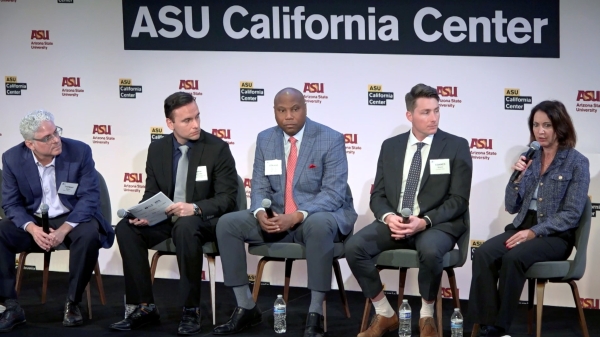
TechTainment conference explores the crossroads of law, technology, entertainment
What protections do writers, actors, producers and others have from AI? Will changing laws around name, image and likeness (NIL) eliminate less lucrative college sports programs?And what does…

How to watch an election
Every election night, adrenaline pumps through newsrooms across the country as journalists take the pulse of democracy. We gathered three veteran reporters — each of them faculty at the Walter…
Law experts, students gather to celebrate ASU Indian Legal Program
Although she's achieved much in Washington, D.C., Mikaela Bledsoe Downes’ education is bringing her closer to her intended destination — returning home to the Winnebago tribe in Nebraska with her…

